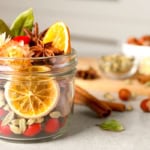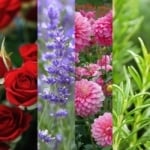Grow A Bee-Friendly Lawn And Garden
Compelling reasons and benefits on why a lawn filled with dandelions and clover may just be the best choice.

When visiting a friend in her beautiful Atlanta home, I couldn’t take my eyes off the lawn. It was small but impressive. The grass was so thick and green, the perfect lawn, not a weed in sight, like a fresh manicure. I couldn’t help but chuckle at the thought of seeing our country landscape in the middle of this suburban block. I’m afraid we’d receive knocks on the door from lawn services offering to lend a hand.
It isn’t that we’re lazy. We mow our lawn often, to discourage snakes from hiding in the grass. We have a lawn philosophy, a strategy that we hope you’ll consider if you haven’t already.
Our lawn and meadows are comprised of a varying lot of botanicals. We did plant grass, but there are wildflowers and botanicals that spring up on the landscape: dandelions, wild violets, clover, plantain, chickweed, and water-mint along the creek’s edge. Our lawn strategy includes nourishing the animal kingdom. I love the look and fragrance of fresh cut grass, but I also understand that the bees we tend are in need of natural sources of pollen, nectar, and propolis, especially in the dawn of spring. Bees collect nectar and pollen from plants to feed their colonies, which is especially vital during this time of hive formation and brood production.
Dandelions are among the first wild botanicals that appear on the landscape in spring. So, instead of reaching for a container of weed killer, leave the wildflowers in place to provide food for the bees and their young. Colony Collapse Disorder affects us all. Personally, we lost 5 hives of bees over the winter. Looking to replace the bees that we lost, we were unable to purchase more from our usual source, because he can’t meet the current demand from other beekeepers desiring to replace bees they lost this winter.
You don’t have to be a bee-keeper to do your part to save the bee population from further demise. Instead of spreading or spraying your grass and plants with pesticides, consider planting a bee friendly garden. Bradford pear trees may offer a showy display of spring blooms, but they are not a food source for the bees.
Bee-Friendly Plants
Plant any of these beneficial trees or plants to provide sources of nectar and pollen for honey bees.
Trees for Bees:
- Black locust
- Linden
- Magnolia
- Maple
- Oak
- Tulip poplar
- Willow
- Fruit-bearing trees such as apples, peaches, and almonds, etc.
Plants for Your Bee-Friendly Garden:
- Aster
- Bee balm
- Butterfly bush
- Calendula
- Catmint
- Clematis
- Cosmos
- Crocus
- Dahlia
- Geraniums
- Honeysuckle
- Hyacinth
- Lavender
- Poppies
- Phlox
- Purple coneflower
- Heritage roses
- Snapdragons
- Snowdrops
- Squash
- St. John’s Wort
- Strawberries
- Sunflowers
- Zucchini.
Wild botanicals include
- Blackberries
- Clover
- Dandelions
- Goldenrod
- Plantain
Don’t Forget: Bees Need Water!
Sources of clean water are as important as food to the survival of bees and their colonies. The honey bees we tend to collect water from the statue in our koi pond and along the shallow, still edges of the natural, flowing spring. To provide clean water for bees in your vicinity, keep fresh water in a birdbath or place a water feature in your yard. Bees enjoy a drink of water on a hot day and also use water in the production of honey and larvae food.

Deborah Tukua
Deborah Tukua is a natural living, healthy lifestyle writer and author of 7 non-fiction books, including Pearls of Garden Wisdom: Time-Saving Tips and Techniques from a Country Home, Pearls of Country Wisdom: Hints from a Small Town on Keeping Garden and Home, and Naturally Sweet Blender Treats. Tukua has been a writer for the Farmers' Almanac since 2004.






I believe another major cause, believe it or not, is riding lawnmowers. When I was young, most people only had push mowers, they’d keep the yard around their homes mowed, but their land surrounding they let grow-up, perhaps only cut it once a year if that. Nowadays, seems everyone wants to keep all their land like a golf course. If you can, let some of your property grow up and produce wildflowers (even if you have to plant them to get them started) You will be rewarded with bees, butterflies, and hummingbirds, much better than acres of just short grass.
I am always finding bees drinking from the birdfeeder or if I’m watering my garden they get on the leaves for a drop of water. They must really struggle to find water-it is literally all the time….
LeeAnn, Great comment. Cut your lawn at 3 inch or higher & most clover flowers remain.
Great post. I have mostly clover and it is green and lush and cool, and the bees love it. I don’t care what anyone states about messy lawns. Who cares. One bee is better than no bees. I purposely planted a ton of pollinators and with great success. It is about paying attention and really listening to what nature has to tell us. We are at a critical point. It’s time to participate and give back. For those who have a selfish heart and feel it is someone else who should propagate pollinators. Just remember-“Nature takes care of those who love her.” That means giving back. Human beings need to stop being parasites. Give back now. Be part of the collective. Want food? Promote bees.
I’ve had a hive of bees for 3 summers now. I lost the first year’s hive in the winter; but this past winter was brutal in Ohio; yet my bees survived. I tell my lawn man to let the grass grow when clover and dandelions are visible. No matter what the weather: hot, cold, rainy, or balmy, my bees do NOT work the clover or dandelions enough to make it worth having a messy lawn. I daily walk a part of the 5-6 acres (acres!) of lawn around our home (a total landscape of clover for the past 3-4 weeks,) and I’m lucky if I see a dozen (12!) honey bees on the clover. I’ve heard all the excuses from other bee keepers; but I am beginning to think there’s no point in letting the clover take over my yard. They’ll find the pollen and nectar some other place; and the honey on the comb is a nice light color.
This is all such wonderful advice! I don’t spray for weeds either, and I wish more people would not. The city sprays for mosquitoes each spring; yet, we have an abundance of mosquitoes! My theory is that the spray kills the good insects, the bees, butterflies, and dragonflies. If the city asked my advice (which they don’t), I’d advise importing a bunch of dragonflies, which are the mosquitoes’ natural enemy, and stop spraying!
WoW! now I know why my yard was “yellow” with dandelions this Spring. God is trying to tell us something? We are so eager to keep our yards mowed (to keep up with a neighbor) that we forget about “saving the bees”…..